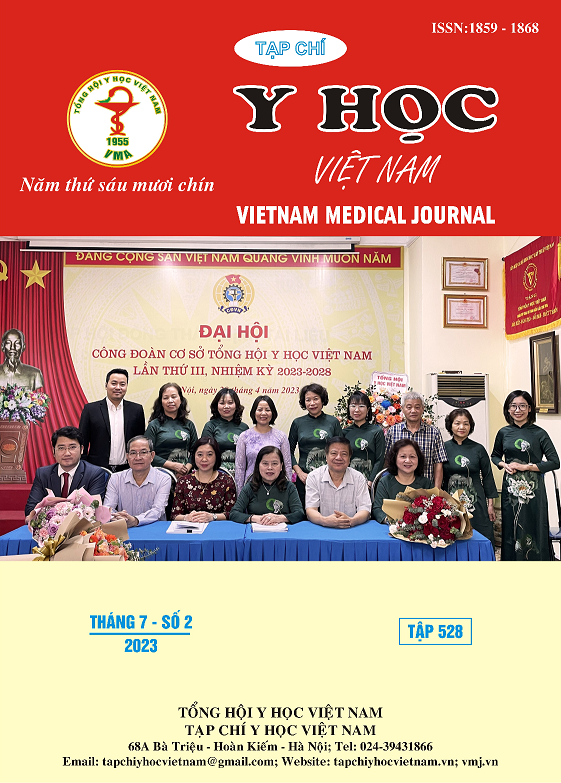CLINICAL AND SUBCLINICAL CHARACTERISTICS IN YOUNG AND ADOLESCENT MENORRHAGIA PATIENTS AT THE NATIONAL HOSPITAL OF OBSTETRICS AND GYNECOLOGY
Main Article Content
Abstract
Objective: To describe the clinical and subclinical characteristics of young and adolescent patients with menorrhagia at the National Hospital of Obstetrics and Gynecology. Materials and Methods: This retrospective descriptive study was carried out based on 108 medical records of functional menorrhagia patients aged 10 to 24 years at the National Hospital of Obstetrics and Gynecology in 2019 and 2020. Results: Adolescents account for 86.1%. The mean age of the study was 16.05 ± 3.47 years old. Married patients are very low 5.56%. Patients have never had sex account for 90.74%. In the group of menorrhagia from 7 to 15 days, the rate of patients with blood clots was the highest, accounting for 54.5%. The number of patients with normal hemoglobin is very low: 8.3%. Patients with hemoglobin below 80 g/l accounted for the highest rate (63.9%). There were 2 patients with very low hemoglobin, only at 30-39 g/l, 6 patients with hemoglobin at 40-49 g/l . Endometrial lining less than 5mm: 100% of patients have menorrhagia for 16-30 days. Endometrial lining over 10mm: patients with menorrhagia for 16-30 days is the highest (47.1%), patients with menorrhagia over 30 days is high (23.5%). Conclusion: The mean age of the study was 16.05 ± 3.47 years old. Patients who have not had sex are 90.74%. Patients with hemoglobin less than 80 g/l accounted for the highest rate (63.9%). There were 8 patients with very low hemoglobin, only at 30-49 g/l. Endometrial lining over 10mm: patients with menorrhagia for 16-30 days is the highest (47.1%), patients with menorrhagia over 30 days is high (23.5%).
Article Details
Keywords
Clinical, subclinical, functional menorrhagia, young age.
References
2. Nguyễn Viết Tiến. Sinh lý kinh nguyệt và điều trị RKRH cơ năng bằng hormon. Nhà xuất bản Y học; 2013.
3. Dương Thị Cương. Phụ khoa dành cho thầy thuốc thực hành. Nhà xuất bản Y học; 2004.
4. Furlong. Bleeding disorders, menorrhagia and iron deficiency: impacts on health-related quality of life. Haemophilia: the official journal of the World Federation of Hemophilia. 2013;19: 385-391.
5. Yaşa et Güngör Uğurlucan. Approach to Abnormal Uterine Bleeding in Adolescents. Journal of Clinical Research in Pediatric Endocrinology. 2020;12: 1-6.
6. World Health Organization (WHO). Haemoglobin concentrations for the diagnosis of anaemia and assessment of severity. VMNIS. 2011.
7. Lê Thị Thanh Vân. Đặc điểm lâm sàng của rong kinh, rong huyết cơ năng. Tuổi dậy thì và tuổi tiền mãn kinh. Luận án Tiến sỹ Y học. Đại học Y Hà Nội, Hà Nội; 2003.
8. Nguyễn Viết Tiến. Tác dụng của estrogen và progestin trong điều trị RKRH tuổi trẻ. Trường Đại học Y Hà Nội; 2004.
9. Nguyễn Thị Thuỷ. Bước đầu đánh giá hiệu quả điều trị rong kinh tuổi trẻ bằng viên thuốc rigevidon tại Viện Bảo vệ Bà mẹ và Trẻ sơ sinh. Luận văn tốt nghiệp Bác sĩ Y khoa. Trường đại học Y Hà Nội, 2001.
10. Phạm Thị Bình. Nghiên cứu một số phương pháp điều trị RKRHCN tại bệnh viện Phụ sản Trung ương. Trường Đại học Y Hà Nội; 2003.


